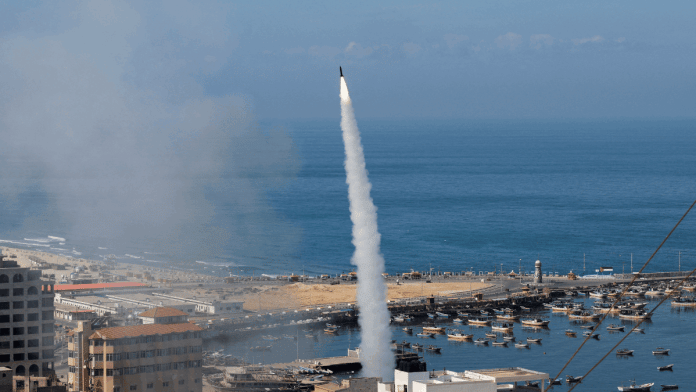New Delhi: The Palestinian militant group, Hamas, launched an unprecedented ‘surprise’ aerial and ground attack against Israel Saturday. Israeli Prime Minister Benjamin Netanyahu declared that the country is “at war” as one of the most serious escalations between Israel and Hamas, a militant group with roots in the first Intifada, unfolded.
Hamas claimed to have launched roughly 5,000 missiles Saturday morning from Gaza Strip, a territory under the militant group’s control since 2007. Israelis and Palestinians have fought four wars and several smaller clashes in this region over the last 15 years.
The Palestinian exclave, Gaza, borders Israel, Egypt and the eastern coast of the Mediterranean Sea. The 365 square km-strip, which is home to over 20 lakh people, has been subjected to an Israel-imposed land, sea and air blockade for the past 15-odd years.
A 2018 report by the Norwegian Refugee Council said that despite being largely isolated, it is one of the world’s most densely populated areas, with more than 5,000 inhabitants per square km, living across five governorates, namely North Gaza, Gaza City, Deir al-Balah, Khan Yunis, and Rafah.
Also read: ‘Civilians sleeping in their beds attacked’ — Israel mounts counter-offensive against Hamas
‘World’s largest open-air prison’
Israel imposed a blockade on the Gaza Strip in 2007, after the Hamas takeover, maintaining that it was essential to prevent the smuggling of weapons and materials that could be used for military purposes by Hamas and other groups in Gaza.
Surrounded by 55 km of eight-metre-high walls, the blockade has isolated the strip from the world as well as the rest of the region. These restrictions obstruct the movement of people in and out of Gaza, limiting their ability to travel for work, study, medical treatment, or to visit family. Moreover, it restricts the flow of essential items such as fuel, and medical supplies through Israel controlled border checkpoints surrounding the strip.
Human rights groups have called the region “the world’s largest open-air prison” and the conditions prevailing there a violation of international humanitarian law. In this context, reports also cite the Fourth Geneva Convention that “prohibits collective punishment” and requires an “occupying power to ensure the welfare of the occupied population”.
While Israel maintains that the Fourth Fourth Geneva Convention does not apply to West Bank and Gaza, the UN Security Council contends that its scope “is applicable to the Israeli-occupied territories of the West Bank and Gaza”.
Due to these limitations and other challenges, a generation of Palestinians has grown up in impoverished conditions, with rising unemployment and poverty.
According to the Geneva-based Euro-Med Human Rights Monitor, unemployment rose to 47 percent by 2022 end from 23.6 percent before the blockade. The poverty rate has also increased to 61.6 percent in 2022 from 40 percent in 2005. Last month, Israel military forces suspended the movement of commercial goods from Gaza to Israel.
According to the UN, less than 5 percent of Gaza’s water is safe to drink. With only one operating power plant, the region has suffered from chronic power shortages, severely affecting essential services such as health, water and sanitation, besides manufacturing and agriculture.
Violence and rising tensions along the West Bank region resulted in the death of 225 Palestinians and 32 Israelis this year, before Saturday’s attack, show media reports.
History of Gaza Strip
The Gaza region has been a point of contention among numerous groups over the past century. Britain took over the region from the Ottoman Empire, at the end of World War I, when the region was inhabited by a Jewish minority and Arab majority. Under British rule, the region became a part of the League of Nations mandate of Palestine in 1922.
Between 1922 and 1947, Jews who fled Nazi persecution from Germany and other parts of Europe in large numbers settled in the region.
However, the Arab population’s demands for independence and opposition to the immigrants led to a violent rebellion in 1937. Eventually, in 1947, the UN terminated the mandate and through a resolution proposed to divide the region into two independent states, one Palestinian Arab and the other Jewish, while Jerusalem, a city both communities claim to be of religious significance, was placed under a special international regime.
The Jewish state proclaimed its independence as Israel and along with its neighbouring Arab States, in the 1948 Arab-Israeli war, expanded its territory to occupy 77 percent of the previously-recognised mandate Palestine, which included the larger part of Jerusalem.
Jordan and Egypt took over the rest of the territory assigned to the Arab State, with control of the newly-formed Gaza Strip going to Egypt. However, Israel later took control of the territory, along with the West Bank, in the 1967 war. These wars resulted in a massive exodus of the Palestinian population to other regions.
Consequently, 1973 saw one of the biggest escalations between Israel and the Arab states, known as the Yom Kippur War. Here, a coalition of Arab states led by Egypt and Syria joined forces and launched a two-front offensive against Israel, from the north and the south. After initial loss of some of its territory, Israel was quickly able to gain them back in a counter-offensive. The roughly 20 day-long war ended with a cease-fire agreement, brokered by the USA and the Soviet Union.
Ultimately, between 1994 and 1999, Israel transferred security and civilian responsibility for much of the Gaza Strip and the West Bank to the Palestinian Authority, a governing body established in 1994 as part of the Oslo Accords peace agreement between Israel and Palestine Liberation Organization (PLO). The Palestinian Authority governed both Gaza and West Bank, until 2006, when Hamas took control in the last held elections in the region.
(Edited by Smriti Sinha)






